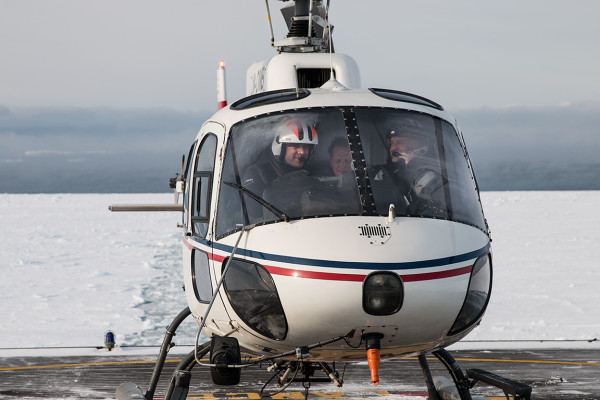
NPI researchers and Brutus Ostling, Canon ambassador, prepare to take off for polar bear survey. © Tom Arnbom / WWF-Canon
From April 11 to 21, 2014, join a Norwegian Polar Institute and WWF-Canon scientific expedition to collect critical data about Europe’s most westerly polar bear population. The population on and around the Norwegian Arctic archipelago of Svalbard is facing a future without summer sea ice. See all posts from the expedition here.
Pitch and roll, pitch and roll as we settled into our bunks last night. Just enough seas to make things interesting. A thud on the hull at 5 AM followed by a familiar hiss and occasional shudder stirs me to wake. The boat motion is now perfectly still and it takes a minute to discern if we are still moving. Outside the port hole, the churning seas are now solid white- we are in the ice. While not a heavy ice breaker, the Lance is capable of cruising through shore fast and most first year ice.
When I come up to the bridge, we are almost at 80 degrees latitude approaching the north western tip of Spitsbergen and passing by the old Dutch whaling station of Smeerenburg. Those on our team that are new to the Arctic are already on deck with cameras and binoculars taking stock of this fascinating new sea and icescape. Our videographer Rhineout is all smiles as he jumps from spot to spot looking for unique viewpoints, oblivious to the -17 C temperatures. The bow of the ship is also a frozen ice-scape as spray from our evening cruise in rough seas is frozen on the rigging and anything metallic on deck.
We’ll spend much of the day maneuvering into Woodfjiorden where NPI has a collared female polar bear they hope to recapture. The weather shifts from localized dense fog patches to clear blue skies. Sea bird sightings are common and include guillemots, little auks, fulmars, and even two ivory gulls. Walrus are seen early-morning and we pass closely by five bearded seals mid-day before arriving in the fjord and launching the first helicopter survey.
Polar bear research on the cutting edge
As a polar bear field biologist, this is a great opportunity for me to talk with my colleagues at NPI, Jon Aars and Magnus Anderson, to compare notes and share experiences. Unfortunately, due to schedules and distance, this is altogether too rare amongst our colleagues globally. Each region we work in is unique in some aspects of both general ecology and bear behavior. In Svalbard polar bears share the marine world with the usual suspects- walrus, ringed and bearded seals, along with beluga and the rare bowhead whale, but they also have species here that are new to me- harp and hooded seals, narwhal and fin whale to name a few. NPI also have their own uniquely laid out capture kits and systems of working on bears to collect samples once sedated. This year they are testing an exciting new dart delivery system that, if successful, will be much less invasive than current equipment.
The team at NPI is also pioneering work in the use of geo-location ear tags that store a surprising amount of data on a chip set the size of a small coin- including temperature. These smart tags can provide coarse location data, but the temperature and light information may be able to identify denning events. New technology, improved capture tools, and advances in the drugs available for wildlife capture will continue to advance our understanding of this sentinel species and how it is responding to rapid changes in the Arctic environment.
Changes we are already seeing in real time as both the fjords around Longyearbyen and the one we sit in now should be covered in first year, shore fast ice- but both are completely ice free. Jon has worked here now for 11 years and has never seen so little ice. This not only complicates his research (he cannot safely land on the young ice still available in some areas), it also complicates life for the bears, especially females emerging from maternal dens and looking to hunt on the ice for much needed calories.
Our colleagues also remind us that it’s not just the ice that is missing, parts of Svalbard are receiving less snowfall, and this is starting to impact the primary food of the polar bear- ringed seals. Researchers in eastern Spitsbergen are estimating near complete failure of ringed seal recruitment (survival of newborns to adulthood) in some areas and years due to lack of snow cover for their normally protective snow lairs. This may be an indicator of changes to come as other parts of the Arctic warm, and it is not good news for polar bears.
